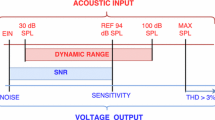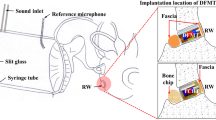Abstract
With the advent of implantable hearing aids, implementation and acoustic sensing strategy of the implantable microphone becomes an important issue; among the many types of implantable microphone, placing the microphone in middle ear cavity (MEC) has advantages including simple operation and insensitive to skin touching or chewing motion. In this paper, an implantable microphone was implemented and researched feedback characteristic when both the implantable microphone and the transducer were placed in the MEC. Analytical and finite element analysis were conducted to design the microphone to have a natural frequency of 7 kHz and showed good characteristics of SNR and sensitivity. For the feedback test, simple analytical and finite element analysis were calculated and compared with in vitro experiments (n = 4). From the experiments, the open-loop gain and feedback factor were measured and the minimum gain margin measured as 14.3 dB.










Similar content being viewed by others
Abbreviations
- TM:
-
Tympanic membrane
- MEC:
-
Middle ear cavity
- SNR:
-
Signal and noise ratio
References
E.P. Hong et al., Application of piezoelectric multi-layered actuator to floating mass transducer for implantable middle ear hearing devices. J. Electroceram. 23, 335–340 (2009)
K.W. Seong et al., Design of a new vibration transducer for implantable middle ear hearing devices. IEEJ Trans. Electr. Electron. Eng. 5, 608–610 (2010)
I.Y. Park et al., Comparisons of electromagnetic and piezoelectric floating-mass transducers in human cadaveric temporal bones. Hear. Res. 272, 187–192 (2011)
M.K. Kim et al., Fabrication and optimal design of differential electromagnetic transducer for implantable middle ear hearing device. Biosens. Bioelectron. 21, 2170–2175 (2006)
S. Tringali et al., Fully implantable hearing device with transducer on the round window as a treatment of mixed hearing loss. Auris Nasus Larynx 36, 353–358 (2009)
S. Murali et al., Totally implantable hearing aid surgical technique and the first Indian experience with Envoy esteem. Indian J. Otolaryngol. Head Neck Surg. 61, 245–251 (2009)
E.S. Jung et al., Implantable microphone with acoustic tube for fully implantable hearing devices. Ieice Electron. Express 8, 215–219 (2011)
A.E. Deddens et al., Totally implantable hearing aids: the effects of skin thickness on microphone function. Am. J. Otolaryngol. 11, 1–4 (1990)
H. Leysieffer et al., Ein implantierbares mikrofon für elektronische hörimplantate. HNO 45, 816–827 (1997)
H.A. Jenkins et al., Anatomical vibrations that implantable microphones must overcome. Otol. Neurotol. 28, 579–588 (2007). doi:10.1097/01.mao.0000271700.52982.d8
A. Vujanic et al., in Microelectronics, 2002. “Development of a totally implantable hearing aid”, vol. 1 (MIEL 2002. 23rd International Conference on, 2002), pp. 235–238
Z. Djinovic et al., Investigation and development of a fiber-optic vibrometer for use in totally implantable hearing aids. Strojniski Vestn. J. Mech. Eng. 52, 470–476 (2006)
M.A. Zurcher et al., A MEMS capacitive accelerometer design as middle ear microphone based on ossicular chain micromechanic characterization at umbo for fully implantable cochlear prosthesis. Sens. Mater. 22, 297–312 (2010)
M. Barbara et al., The totally implantable middle ear device “Esteem” for rehabilitation of severe sensorineural hearing loss. Acta Otolaryngol. 131, 399–404 (2011)
S.H.A. Woo et al., “Simulation of an implantable microphone in the middle ear cavity”. Int’l Conf. Bioinforma. Comput. Biol., pp. 360–363, (2012)
D.J. Freed, Adaptive feedback cancellation in hearing aids with clipping in the feedback path. J. Acoust. Soc. Am. 123, 1618–1626 (2008)
J.A. Maxwell, P.M. Zurek, Reducing acoustic feedback in hearing aids. Speech Audio Proc. IEEE Trans. 3, 304–313 (1995)
D.K. Bustamante et al., in Acoustics, Speech, and Signal Processing, 1989. “Measurement and adaptive suppression of acoustic feedback in hearing aids”, vol. 3. (ICASSP-89., 1989 International Conference on, 1989), pp. 2017–2020
S.E. Voss et al., Acoustic responses of the human middle ear. Hear. Res. 150, 43–69 (2000)
A.C.T. Harrie, Equivalent circuit representation of electromechanical transducers: I. Lumped-parameter systems. J. Micromech. Microeng. 6, 157 (1996)
L.C. Kuypers et al., Thickness of the gerbil tympanic membrane measured with confocal microscopy. Hear. Res. 209, 42–52 (2005)
J. Zwislocki, Analysis of the middle-ear function. Part II: guinea-pig ear. J. Acoust. Soc. Am. 35, 1034–1040 (1963)
K. Gyo et al., Effect of middle ear modification on umbo vibration: human temporal bone experiments with a new vibration measuring system. Arch Otolaryngol. Head Neck Surg. 112, 1262–1268 (1986)
K.R. Whittemore et al., Acoustic mechanisms. Otolaryngol. Head Neck Surg 118, 751–761 (1998)
S.M. Hesabgar et al., Measuring the quasi-static Young’s modulus of the eardrum using an indentation technique. Hear. Res. 263, 168–176 (2010)
H.Y. Luo, et al., “Measurement of young’s modulus of human tympanic membrane at high strain rates”. J. Biomech. Eng. 131, (2009)
Author information
Authors and Affiliations
Corresponding author
Additional information
S. T. Woo is equally contributed author.
Rights and permissions
About this article
Cite this article
Arman Woo, S.H., Woo, S.T., Song, B.S. et al. Feedback characteristics between implantable microphone and transducer in middle ear cavity. Biomed Microdevices 15, 867–877 (2013). https://doi.org/10.1007/s10544-013-9774-8
Published:
Issue Date:
DOI: https://doi.org/10.1007/s10544-013-9774-8




